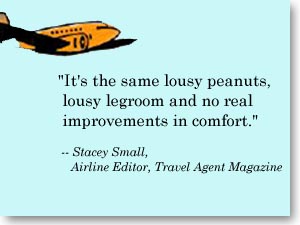|
On a wing and a prayer...
|
 |
February 5, 1998: 3:24 p.m. ET
As resurgent airlines trim costs, can coach class survive on peanuts alone?
|
NEW YORK (CNNfn) - Psst. Have you heard about the other great conspiracy stalking the American plain, the one supported not by the right wing, or the left wing - but by both wings?
Snicker if you want, but Lawton Roberts, an Atlanta-area travel agent, is dead serious about his crusade against America's $4.5 billion airline industry, whose corporate chieftains he likens to the erstwhile robber barons of the turn-of-the-century oil industry.
"It's an anti-competitive, fraudulent, monopolistic, punitive and predatory oligopoly," Roberts proclaims, trotting out one of the scathing refrains from his new book, Unfair at any Fare.
Just when America's largest domestic carriers are enjoying a newfound resurgence, having ferried a record 600 million travelers to cruising altitude in 1997, Roberts and other vocal critics are reaching a cruising attitude of intolerance.
Lost amid all the Wall Street ballyhoo over last year's sky-high earnings, they contend, is a sober-minded appraisal of how the airlines got there - and at what cost to the average flyer.

Stacey Small, the airline editor for Travel Agent magazine, speaks for scores of disgruntled fellow flyers behind the bulkheads when she grouses, "It's the same lousy peanuts, lousy legroom and no real improvements in comfort. You never hear of people getting off their plane and talking about how great their flight was."
Purging the macho mindset
However, airline executives and industry observers retort they are only doing their job - just a lot better and more efficiently than in the past. To do otherwise, suggests David Fuscus, the head of communications for the Washington-based trade group, Air Transport Association of America, would be to invite a return to the almost suicidal aviation climate of the early 90s, when the industry lost $13 billion, leading to the demise of such household names as Pan-Am and Eastern.
"In the past there has always been this mindset in the industry, when times are good, you go out and buy a lot of shiny new planes," said Fuscus.
"Airlines are now managing their capacity a lot better…What the smart airlines are doing today is they are planning for the next downturn, making sure your costs are down, making sure you are in areas that are growing."
Judging from the numbers, many airlines are applying that formula with stunning success. Take Northwest Airlines Corp., the nation's fourth-largest carrier, which posted a record $105.4 million profit in the fourth quarter ended Dec. 31 - quadruple the $26 million the company earned in the comparable period a year ago.
Not too long ago, such growth rates would have been accompanied with news of a merger but Northwest followed up by unveiling a novel alliance with rival Continental that involves the purchase of 14 percent of Continental's common stock for $514 million, and the acquisition of 51 percent of its voting rights.
In an interview with CNNfn, John Dasburg, Northwest's chief executive officer, called an alliance an "ideal relationship" for the two companies, given their minimal overlap. He said the deal, which analysts believe could trigger more consolidation among U.S. airlines, was the outcome of a strategic rethinking, begun in 1994, to "draw losing flying from the periphery of our system" and refocus on three main hubs in Houston, Detroit and Minneapolis/St. Paul.
In so doing, Dasburg said, Northwest turned its attention to developing more sophisticated systems for handling "yield management." That is airline parlance for the unscientific science by which airlines tweak fare schedules and allocate seats in an effort to strike a viable balance between premium-paying passengers and leisure travelers flying on discounts.
An extra carry-on for first class
Today, yield management-chic is the latest craze sweeping the airline industry -- venerated by CEOs and vilified by people like Roberts, who decry it as little more than a fancy way of bilking passengers without leaving a trace.
The trend is not without its creative brainstorms: one airline, to encourage more premium-fare travel, allows business and first-class passengers an extra carry-on bag. Another has placed paid advertisements encouraging flyers to book their trips themselves over the Internet, to spare the airline the expense of a commission to a travel agent.
All this, needless to say, is cutting-edge cost-shaving. For years -- especially in the fratricidal flying environment that prevailed in the aftermath of deregulation in 1978 - airlines botched yield management badly, and paid the price in lost profit.
Perry Flint, the executive editor of Air Transport World, calls this gung-ho era the age of "ubiquity".
"You had to be everywhere, you had to have a dozen hubs around the country, you couldn't shrink your way to profitability," said Flint. "You had this situation where everyone had hundreds of planes on order, they were all flying against each other, they vastly overstretched."
In a classic case of hub overload, at one point, American Airlines maintained six hubs, including three in Raleigh/Durham, Nashville and San Jose that have all since been abandoned. The ever-growing number of contested hubs led to price warfare on a scale that ultimately proved detrimental to the industry and led to a slew of abortive mergers in the 80s.
By contrast, the received wisdom in today's airline industry is that maximizing yield means making more with what you carry. To this end, United Airlines recently conducted a study that indicated that nine percent of its passengers accounted for 44 percent of revenue.
The elusive full fare
Flint, for his part, cites figures showing that, after accounting for discount fares, the net yield on US airlines in 1997 was 13.7 cents per seat mile, the standard statistical unit in the industry. The full-fare yield, meanwhile, was 40 cents - though, as Flint points out, only a tiny minority of flyers actually pay full fare. On any given flight, 30 different fares may be in play.
For all their growing savviness, however, the airlines still flunk miserably when it comes to actually setting rational fares, says Lucy Hirlemann, the owner of Berkshire Travel Inc., in Newfoundland, New Jersey.
"This industry has never learned how to price their product, ever," says Hirlemann.
To prove it, she taps a few quick coordinates into her computer keyboard. You want to fly from New York to Chicago in February? There are 107 different fares. From New York to Los Angeles, the choice is even more mind-boggling - 183 fares. United Airlines alone offers 17 fares to Chicago from New York and 20 to Los Angeles.
From the airlines' perspective, the complex fare structure, far from an affront to the passenger, is actually a vehicle for granting travelers greater leeway within the industry's tight pricing constraints. There are budgetary reasons they say, behind the fine print in discount fares that critics say all but lock them into flying on a windy Wednesday and returning on a blue-skied Thursday -- when it's snowing in Wichita.
But not all airlines are prospering in the current boon environment.
On Wednesday, Western Pacific, a regional carrier, grounded its fleet after hobbling along under bankruptcy protection for about four months.
The low-cost airline ceased operations after its backer, Smith Management Co. of New York, cut off funding. Smith Management spent a total of $23 million to keep the embattled carrier airborne. Western Pacific said it was close to an agreement with United Airlines to honor Western Pacific's tickets.
Some carriers, like America West Airlines, which filed for bankruptcy earlier in the decade, have bootstrapped their way back into investors' good graces.
America West's earnings jumped 66 percent in its fourth quarter, to $20.1 million, said spokeswoman Nancy Gore. She noted that the airline has been growing at a rate of eight to 10 percent for the past two years, thanks in no small part to cheaper fuel and sage yield management.
Over this period, the airline carried 18.3 million passengers, mostly out of its principal hubs in Phoenix and Las Vegas. Each of the airline's 200 daily flights out of Phoenix has boasted an average "load factor" of 70 percent - an impressive level by the standards of an industry that has been known to fly near-empty aircraft across the Atlantic.
Higher standards, more complaints
There are those who argue that good yield management today can help buffer, if not entirely shield, an airline from fiscal calamity in the event of a recession. And it can also reap other benefits - for the passenger as well as the airline - though these may not be obvious amid the madcap frenzy that prevails at many airports today.
"There's more service now than there has been in a long time, but the planes have been more crowded," said Helene Baker, of Buckingham Research Group. "But if you look at on-time performance, it's actually improved."
Buckingham noted that some of the discontent may stem from the more stringent standards to which airlines are holding themselves - and one another.
Last year, she said, Delta Airlines led the industry with a 75 percent on-time arrival rate, which was "good enough," Baker said. This year, Delta's performance remained on par, but its ranking nonetheless plunged to seventh place.
None of these arguments sways Roberts, who asserts that yield management promises to propel the industry "to a new greed level."
He and others foresee a not-too-distant future when redeeming frequent flyer miles will require Zen-like forbearance, when legroom will finally disappear altogether, a casualty of forward-table-top creep, and when vacuum-packed peanuts will supplant proper nutrition altogether.
Says Small, the airline editor: "You've got people out there that are fed up and crazy. It's gotten to the point where it's really out of hand."
--By staff writer Douglas Herbert
|
|
|
|
|
 |

|

